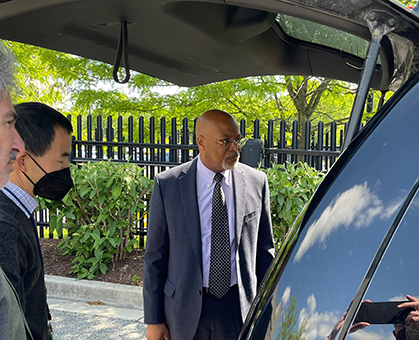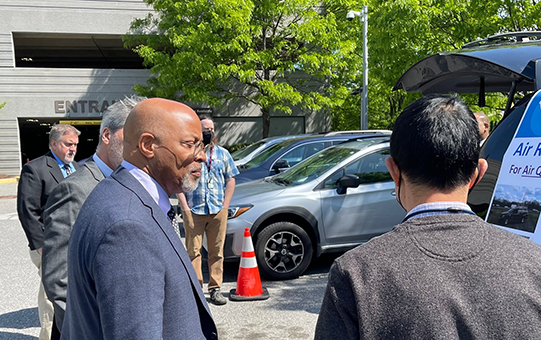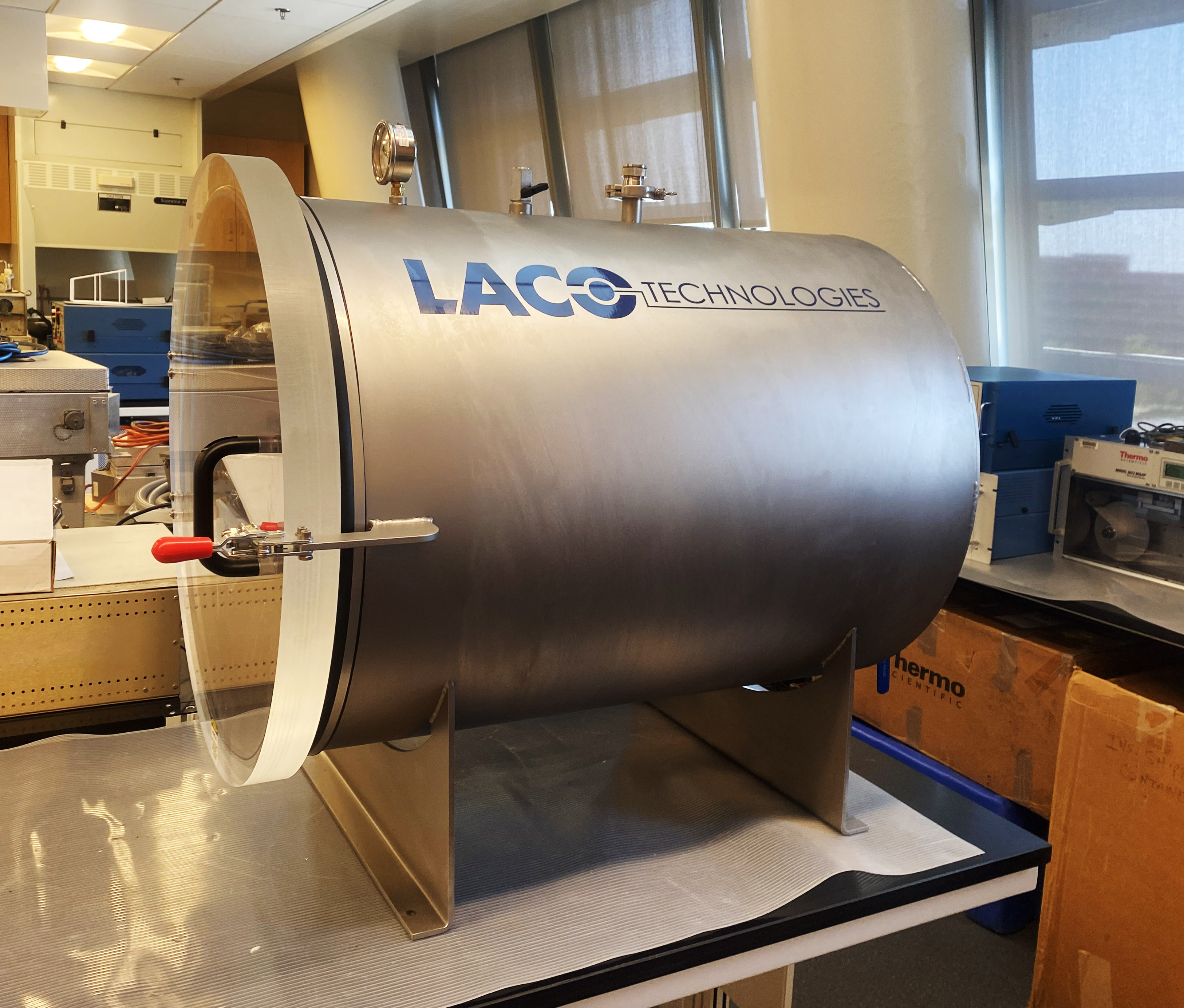ARL Weekly News – April 21, 2023
| Recent Events |
Representative Glenn Ivey (D-MD) visits ARL
On April 24, 2023, Congressman Glenn Ivey (D-MD) from Maryland’s 4th Congressional District made a visit to the NOAA Center for Weather and Climate Prediction (NCWCP) in College Park, MD. At the behest of Dr. Michael Farrar, the director of the National Centers for Environmental Prediction at NCWCP, ARL was invited to participate in a tour and briefing of NCWCP that was conducted that morning for the Congressman. The director of ARL, Dr. Ariel Stein, presented a few slides describing ARL and its work, and at the conclusion of the tour, the Congressman stopped by the ARL Research Car in the NCWCP parking lot to learn about the mobile measurements of greenhouse gases that are part of ARL’s overall research program; the demonstration of the ARC was conducted by Dr. Xinrong Ren and Phillip Stratton, with technical assistance provided by Paul Kelley and Winston Luke; and ARL’s overall participation was coordinated by Howard Diamond.


Laboratory adds Vacuum Chamber
ARL took delivery of a LACO Technologies vacuum chamber, which will be used to quantify the pressure responses of trace gas detectors (for O3, NOx, CO, SO2, CO2, CH4, etc.) flown in the unpressurized University Research Foundation Cessna 402B. The Cessna 402B is used for research flights in the Washington, DC-Baltimore-New York City corridor, as well as in the Marcellus Shale region of Pennsylvania, for measurements of ozone, ozone precursors, and greenhouse gases.
The stainless steel chamber is approximately 24” in diameter by 30” long, and can accommodate a number of sensors at one time. It is leak-tight to sub-torr pressures, but will mainly be used to simulate pressure altitudes from the surface to 20,000 feet ASL. As such, it is an important addition to ARL’s test facilities and platforms.
While the chamber will be permanently housed at ASMD in College Park, it is available for use by any of ARL’s divisions for characterizing sensors that people might wish to send to us for calibration. Please contact Winston Luke (Winston.Luke@noaa.gov) for more information.


| Upcoming Events |
Maryland Day at the University of Maryland: April 29, 2023.
NOAA’s Air Resources Car will be on display at the University of Maryland’s annual Maryland Day festival on Saturday, April 29, 2023 from 10 am to 4pm at the University of Maryland College Park. ARL and the ARC will be on display at McKeldin Mall as part of the Emergency Preparedness Village. More details on Maryland Day are available here: https://marylandday.umd.edu
Call For Papers: 27th Annual George Mason University Conference on Atmospheric Transport and Dispersion Modeling
The 27th Annual George Mason University (GMU) Transport & Dispersion modeling conference will be held on June 20-22, 2023 in-person by George Mason University GMU Fairfax Campus. Abstracts may be submitted by all interested persons. Sponsors include the Air Resources Laboratory (ARL)/NOAA & George Mason University (GMU).
Presentations will be given in the format of a typical conference, with 10 to 15 minutes available for each presentation and its discussions. The technical topics to be included cover a wide range under the general category of atmospheric transport and dispersion modeling. The major topic areas include:
- New developments in basic theories of boundary layer models and transport and dispersion models
- Urban-scale meteorological and dispersion experiments and models
- CFD model theory and applications
- Field experiments and laboratory experiments concerned with boundary layer studies and turbulence and dispersion studies
- Mesoscale meteorological modeling for input to transport and dispersion models
- The use of remote sensing technology in boundary layer and transport and dispersion studies
- Model evaluation methods, uncertainty/sensitivity analyses and risk assessments
- Improvements in model inputs (e.g., land-use data, 3-D building data) and output visualizations.
- Methods and criteria for emergency response and decision-making
- We also welcome ideas from groups interested in arranging special sessions.
For more information: http://camp.cos.gmu.edu/announcement.html
| Publications |
A SmallSat Concept to Resolve Diurnal and Vertical Variations of Aerosols, Clouds, and Boundary Layer Height
The Bulletin of the American Meteorological Society has published online: A SmallSat Concept to Resolve Diurnal and Vertical Variations of Aerosols, Clouds, and Boundary Layer Height
Abstract
A SmallSat mission concept is formulated here to carry out Time-varying Optical Measurements of Clouds and Aerosol Transport (TOMCAT) from space while embracing low-cost opportunities enabled by the revolution in Earth science observation technologies. TOMCAT’s “around-the-clock” measurements will provide needed insights and strong synergy with existing Earth observation satellites to 1) statistically resolve diurnal and vertical variation of cirrus cloud properties (key to Earth’s radiation budget), 2) determine the impacts of regional and seasonal planetary boundary layer (PBL) diurnal variation on surface air quality and low-level cloud distributions, and 3) characterize smoke and dust emission processes impacting their long-range transport on the subseasonal to seasonal time scales. Clouds, aerosol particles, and the PBL play critical roles in Earth’s climate system at multiple spatiotemporal scales. Yet their vertical variations as a function of local time are poorly measured from space. Active sensors for profiling the atmosphere typically utilize sun-synchronous low-Earth orbits (LEO) with rather limited temporal and spatial coverage, inhibiting the characterization of spatiotemporal variability. Pairing compact active lidar and passive multiangle remote sensing technologies from an inclined LEO platform enables measurements of the diurnal and vertical variability of aerosols, clouds, and aerosol-mixing-layer (or PBL) height in tropical-to-midlatitude regions where most of the world’s population resides. TOMCAT is conceived to bring potential societal benefits by delivering its data products in near–real time and offering on-demand hazard-monitoring capabilities to profile fire injection of smoke particles, the frontal lofting of dust particles, and the eruptive rise of volcanic plumes.
Citation: Yorks, J., Wang, J., McGill, M., Follette-Cook, M., Nowottnick, E., Reid, J., Colarco, P., Zhang, J., Kalashnikova, O., Yu, H., Marenco, F., Santanello, J., Weckwerth, T., Li, Z., Campbell, J., Yang, P., Diao, M., Noel, V., Meyer, K., Carr, J., Garay, M., Christian, K., Bennedetti, A., Ring, A., Crawford, A., Pavolonis, M., Aquila, V., Kim, J. and Kondragunta, S. (2023). A SmallSat Concept to Resolve Diurnal and Vertical Variations of Aerosols, Clouds, and Boundary Layer Height. Bulletin of the American Meteorological Society 104(4) pp. E815-E836. Available at: https://journals.ametsoc.org/view/journals/bams/104/4/BAMS-D-21-0179.1.xml [Accessed 26 Apr 2023].

